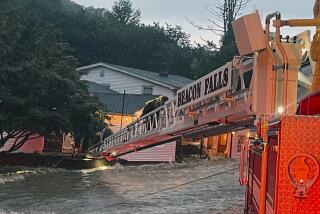Nor’easter brings snow, winds to East Coast, forcing new evacuations
NEW YORK--Wet snow and heavy winds thrashed New York City on Wednesday, forcing new evacuations in areas flooded by Superstorm Sandy last week and knocking out power to some areas where it had just been restored.
At an afternoon briefing, Mayor Michael R. Bloomberg said he ordered the evacuations of four nursing homes that together held more than 600 people in the hard-hit Rockaways. Volunteers were going door to door in low-lying areas of the city, including seafront areas in Brooklyn and in Staten Island, informing residents about the availability of emergency shelters.
“Trees and limbs could come down and storm debris could blow around dangerously,” Bloomberg said. Tree limbs also jeopardize newly repaired high-voltage lines.
PHOTOS: Nor’easter storm hits East Coast | FULL COVERAGE: East Coast hit by deadly storm
The region, however, had braced for Wednesday’s weather -- the first taste of a nor’easter blowing into the region still struggling to recover from Sandy, which made landfall in New Jersey on Oct. 29.
As early evening approached, there were no reports of flooding but New York City posted additional ambulances and small boats near potential flood zones as a precaution, Bloomberg said.
The city’s parks, playgrounds and beaches were closed for 24 hours to keep residents from being injured by falling limbs or flooding.
INTERACTIVE: Before and after Sandy
More than 1,000 flights in and out of airports in the Northeast -- including in New York, Boston, Philadelphia and Newark -- were cancelled due to the new storm, according to the website NYCAviation.com.
There also were reports that customers in the Westchester County suburbs north of New York City had lost power again. An estimated 270,000 homes and businesses in New York and around 370,000 customers in New Jersey were still without electricity on Wednesday.
Although the new storm was expected to carry winds of up to 60 mph, that is far less severe than Sandy, which had hurricane-force winds up to 90 mph. Still, there were worries Wednesday of more flooding in coastal areas that lost some of their beach protection during Sandy.
Federal Emergency Management Agency Administrator Craig Fugate said in a conference call with reporters that FEMA’s cleanup efforts could be delayed by the new storm.
Earlier in the day, at a stop in Harvey Cedars, N.J., New Jersey Gov. Chris Christie urged preparations for the coming storm. “I am waiting for the locusts and pestilence next,” Christie said wearily. “We may take a setback in the next 24 hours.”
With temperatures expected to drop to freezing by nightfall, Bloomberg said 1,500 heaters had been distributed to areas of the city where there is electrical power, but no heat yet.
Some residents, whose homes were flooded, have been told to stay away from low-lying areas, the mayor said.
FEMA was still amassing statistics on the number of people displaced by Sandy, Fugate said. So far, about 295,000 people have registered with FEMA and about $286 million in aid has been disbursed in the states hit by Sandy.
The storm was expected to bring just a few inches of snow to New York City, but more to outlying areas. According to the weather service, sections of New England could get six to 12 inches.
Flood warnings were already posted for the coasts and high-wind warnings were in effect for parts of New Jersey and Long Island.
ALSO:East Coast awaits another wet and windy storm
One patient found dead in North Carolina hospital fire
Bales said, ‘You guys are going to thank me,’ soldiers testify
More to Read
Sign up for Essential California
The most important California stories and recommendations in your inbox every morning.
You may occasionally receive promotional content from the Los Angeles Times.












